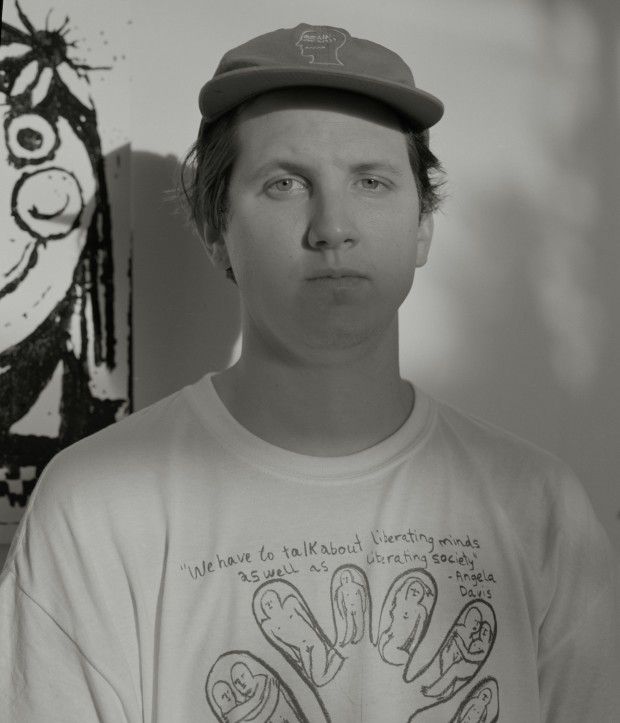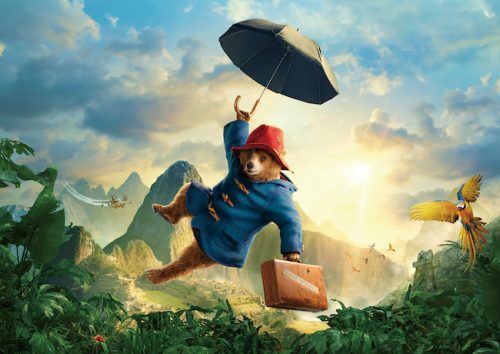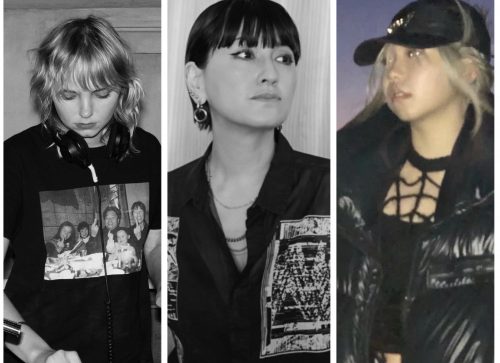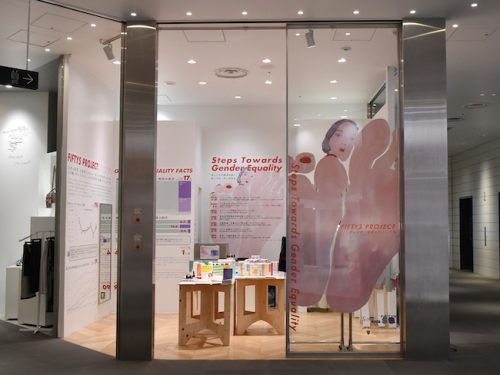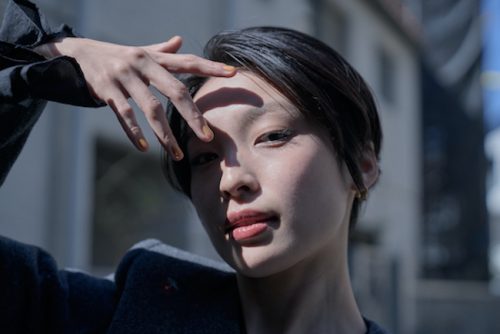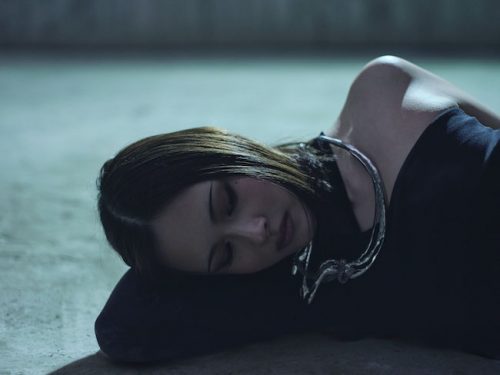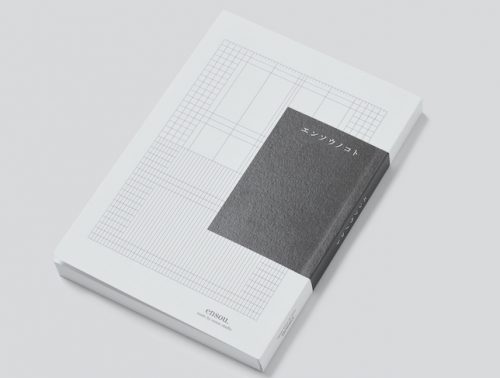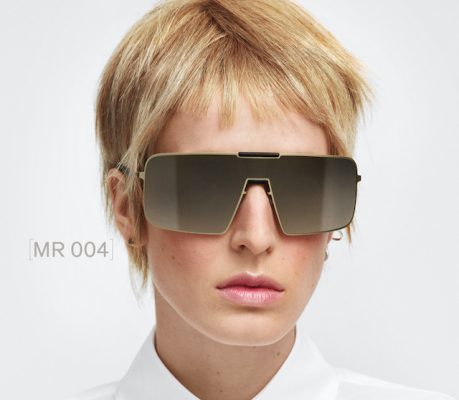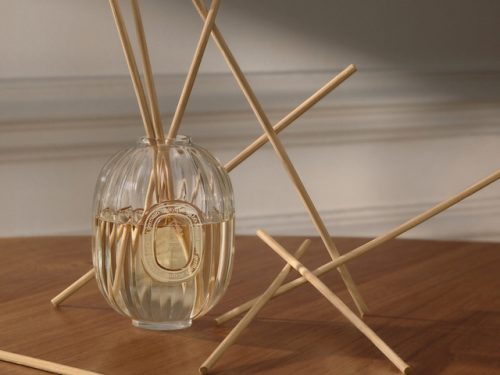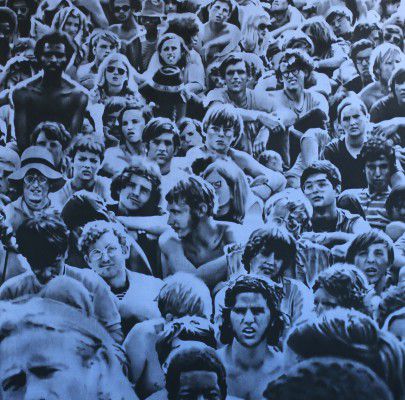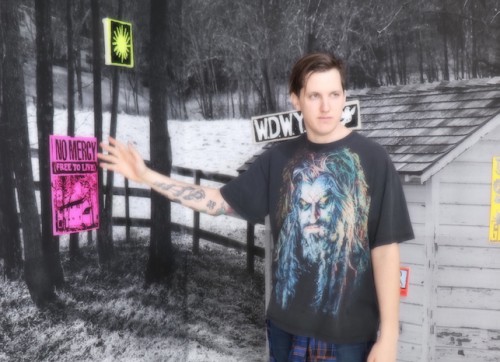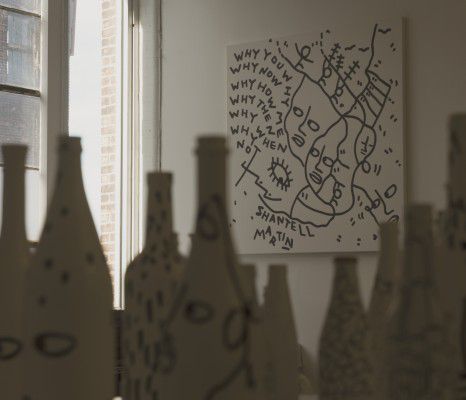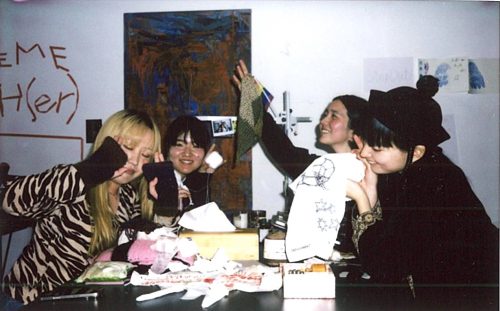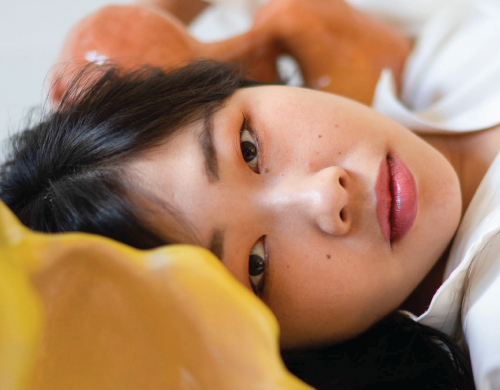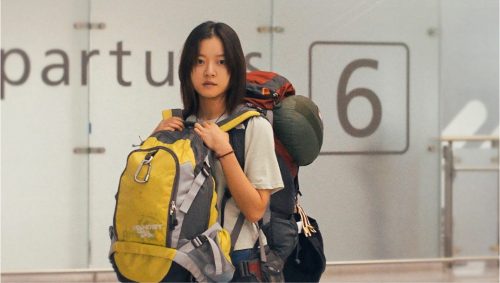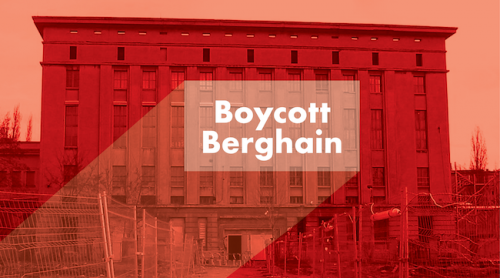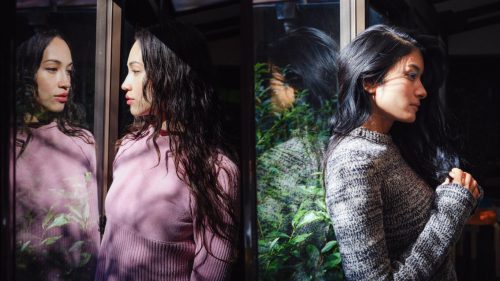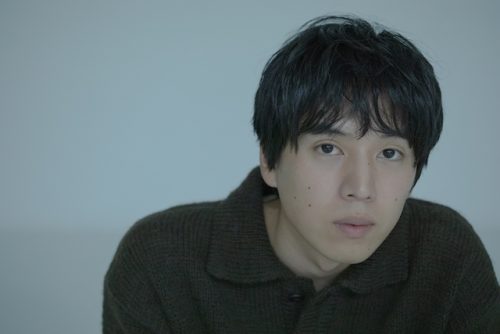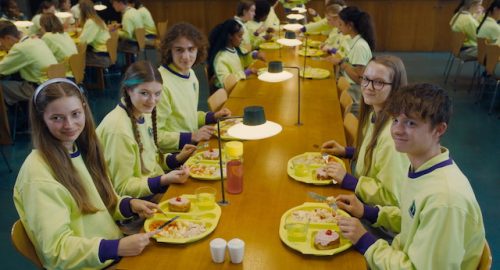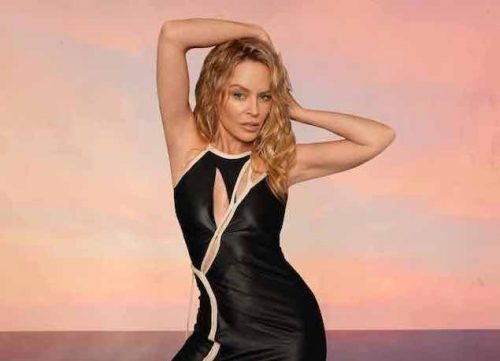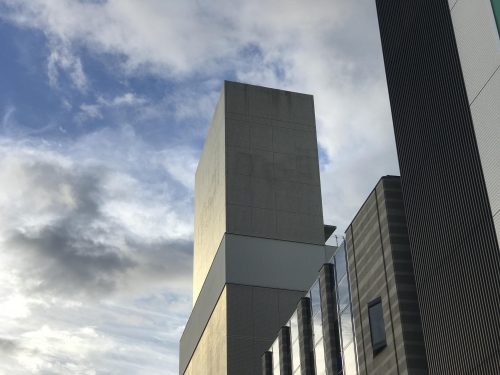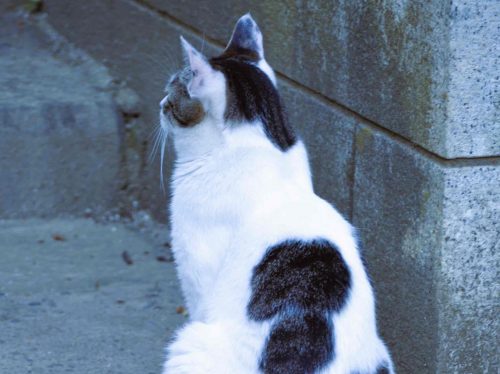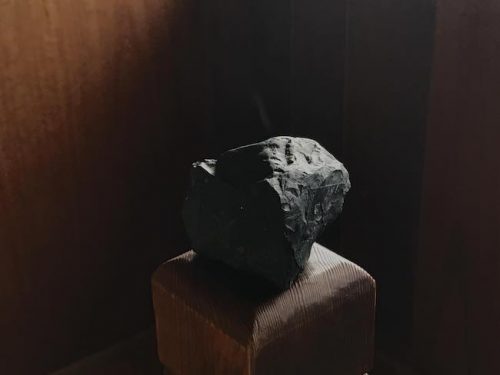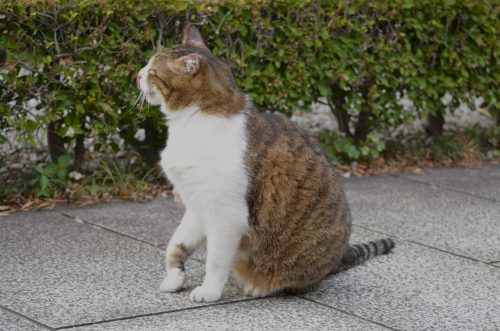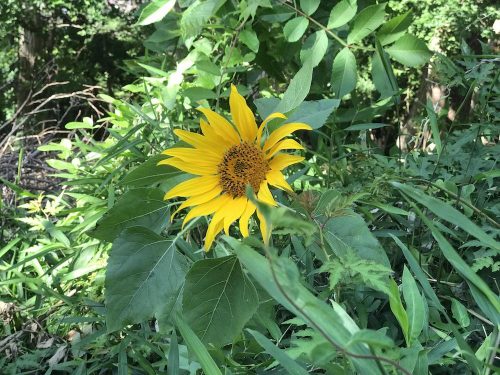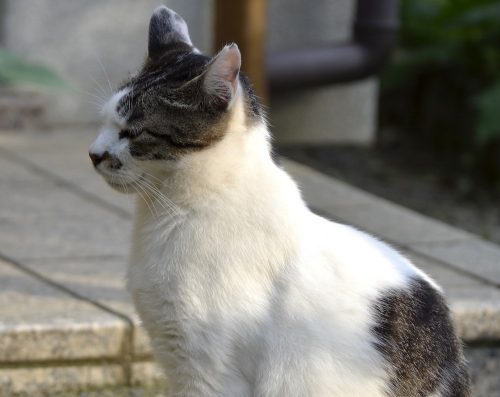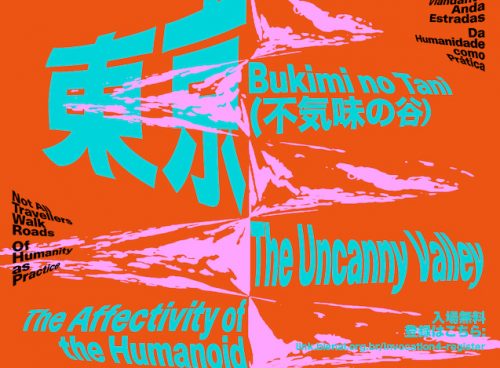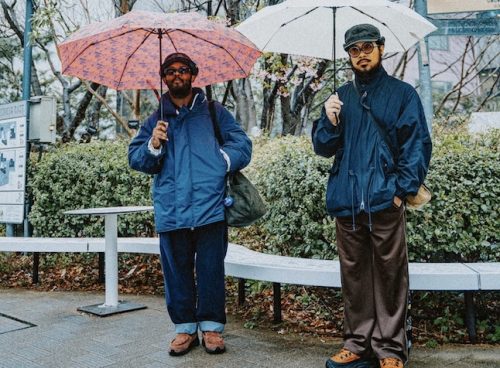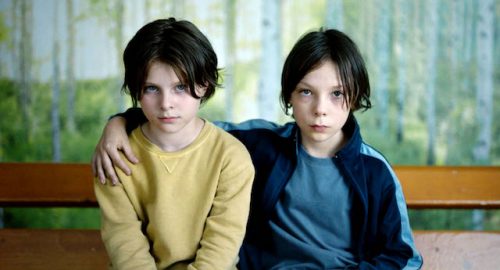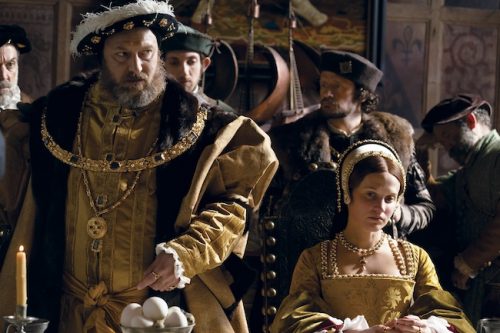BRAIN DEADへの作品提供やアウトサイダーアートのMary T. Smithとの二人展でも注目を集めるアーティスト、B.Thom Stevenson。イラストレーションから油絵、彫刻に至るまで様々な表現方法を探求する彼は、大きな窓から美しい景色を眺められるスタジオで、幼馴染の妻と賢い犬と共に作品を生み出すことができる今が一番充実していると言う。
——今どんな作品を作っているんですか。
B.Thom「新しくキルト・ペインティングを始めたり、油絵もたくさん描いている。ドローイングもね。僕はペイントやドローイング、彫刻など、一度にいろんな作品に取り掛かって、それぞれを作っていくスタイルなんだけど、そうすると次々に移っていけるのがいいんだ。最近はノンストレッチのキャンバスにペイントして、後で伸ばすってことをやっている。ストレッチャーは高いし、伸ばすのに労力と時間も使うから、いざ描こうとする頃には貴重なものに感じて緊張してしまうんだ。だからもっとリラックスして自由に作品を作れるようノンストレッチに描いていた。こういう絵やアブストラクトな油絵もやっているんだ。Josh Smithの作品に似ているけど、本能的ではありながら何を描くか考えているからそれよりはもう少し意図的な感じだと思う。こういう修練を楽しんだり、この夏は締め切りなどにあまり縛られないようにしようとしていた。もうすぐショーがあるからもう少し準備するべきなのかもしれないけど、他の作品に気を取られていたんだ。なんだかアートバカンスみたいだった」
——もともと絵を描くのが好きでしたか。なんでも家族の影響が強いそうですね。
B.Thom「うん、家族に影響されているアーティストは多いと思うよ。僕は大家族で育ったんだ。子供の頃はすぐ気が散っちゃって、ちょっと問題児だったんだけど、アートをやらせておいたら他のことから気をそらせることに気づいたんだと思う。クリエイティヴな親戚は多いんだ。キルトは、祖母の影響が強い。祖父母はアイルランドから渡米してしてきて、家族のためにブランケットを作っていたんだ。便利だけどすごくクリエイティヴなブランケットだった。祖母は賢くて、すごく素敵な作品を作っていたから、それを見てキルト・ペインティングのアイデアも浮かんだんだ。小さな作品を繋げて大きな作品にしてるんだけど、それって家族みたいだろう?」
——子供の頃に作ったもので自慢の作品は?
B.Thom「3年生の時にあったアートコンテストの作品かな。透明のお城を描いてコンテストに出したかったんだけど、どう作ればいいか分からくてイタズラ好きの祖父に相談したんだ。そしたら、『何も描かないんだよ』って言われて、空白の作品を出した。銀色のマイラー(ポリエステルフィルム)に白い絵の具を塗ったんだ。おじいちゃんは大爆笑して、誇りに思ってくれたと思う。振り返ってみると、3年生にしてはちょっとスマートな発想だったかもしれないね。おじいちゃんに認められたかっただけなんだけど、この作品はWooster Art Museumに展示されることになった。もしアートへの興味が深まった出来事を一つ選ばなくてはいけないとしたら、その絵にまつわる出来事かな。小学3年生にしてはすごくコンセプチャルな発想だったよね。ただ生意気に楽しんでいたんだ」
——アートスクールでイラストを専攻したのはなぜ?
B.Thom「入学当初はグラフィック・デザインを専攻していたけど、一学期しかやらなかった。僕の親はアートで生活できるとは思っていなかったから、アートスクールに通うことに反対していて、それをグラフィック・デザインは儲かる職業だからって説得して入学したんだよ。でもクラスメイトと話していて親の許可なしでも専攻を変えられることを知ったから、彫刻に変更した。まだ18歳になったばかりだったから、何をするにも親の許可が必要だと勘違いしていたんだけど、自分で学費を払っていたし、親の人生ではなく僕の人生だからってことで変えることにした。でもしばらくしたらペインティングをやりたくなって、また専攻を変えて。ペインティングは悪いプログラムじゃなかったけど、僕には合わなかった。そのプログラム出身の友達で素敵な画家もいるけど、みんなフィギュラティヴ・アートを作っているんだ。僕ももしペインティングを続けていたら、今はフィギュラティヴ・アートを作っていると思う。で、どうしようと迷っていた時にKurt Vargo教授と話したら、彼が『イラストレーションはアブストラクトな問題解決方法なんだ』って言ってて、アブストラクトな問題をアブストラクトな方法で解くというのはすごくいいなと思った。僕は作品を通して直線的ではない話を伝えたり、実在しない問題に対してアブストラクトな答えを出しているんだ。デタラメな言語で事実を伝えている感じ。イラストレーションを専攻しなかったら学ばなかった技術もあるし、素早く作業をできるようにもなったから良かったと思うよ。なんかいつの間にかこうなっていたんだ」
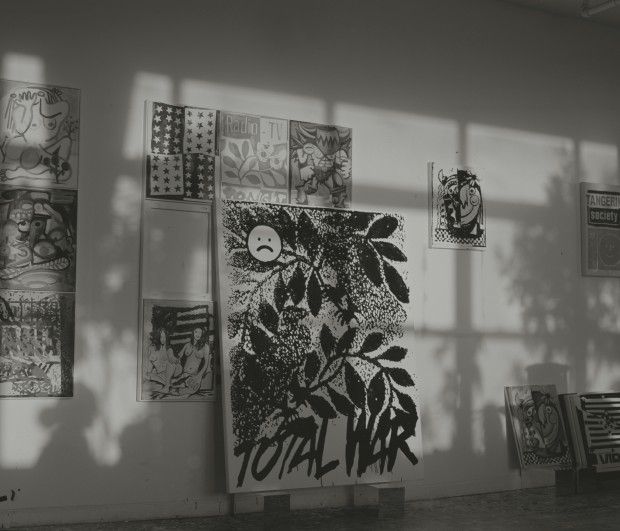
——文字が入っている作品もありますが、その場合の文字はデザイン的要素として捉えているのか、言葉の意味まで考えているのかどちらですか。
B.Thom「両方だと思う。でも、まずは見た目かな。ほとんどが意味よりデザイン性で選んでいる。アブストラクトな物に意味を持たせたら、イメージを補うキャプションのようになるし、人々がそれを見てどう反応するかが面白いんだ。抽象的な物の意味や自分自身について考えさせたいんだよ、ロールシャッハテストみたいにね。僕自身は作品の意味はあんまり考えずに潜在意識や無意識に任せて作っている。早いスピードでまとめあげているから考える暇がないんだ。METALという文字が入ってる作品は、買い物リストにたまたま書いてあった文字が目についたから取り入れたんだよ(笑)」
——壁やキャンバス以外にもいろんな素材に作品を描いたり、飾ったりしていますが、それはなぜ?
B.Thom「わからないな。ある場所に飾ることを目的に作ることはあまりなくて、おもしろい素材があったら使う感じだね。例えば、あの木に飾ってあるのは下描きのスケッチなんだ。コピーやコラージュでの習作が多いから応用できるものが好きなんだと思う。Tシャツを作るのも、応用できたり機能的なアイデアが好きだから。美しいイメージはキャンバスに描く必要も額に入れる必要もないと思う。電信柱を絵で包むのも、ドラム缶や波型金属板に描くのもいいね。波型金属板からはノスタルジーを感じるんだ。Shrineというギャラリーのショーのために電信柱に作品を飾ったんだけど、電信柱を見ると自分が育った場所を思い出すんだよね。そこに意味や効果が必要ではないし、作品の一部としては見ていない。ラジオステーションが二局同時に流れちゃった時のように、たまたま被さった感じかな」
——本能的な感情と計画性のバランスをどうとっているんでしょう。
B.Thom「どちらも活かせるようにしているよ。本能のままに描くこともあれば、それを写真に撮ってコピーしてコラージュしたりするのには思索をしている。あとはバランスをとれるように妻に助けてもらっている。彼女はスタジオ・マネージャーなんだ。僕は整理することが苦手だから、彼女が物事を計画立ててやれるようにしてくれる。僕は別の仕事もしているんだけど、仕事が終わった後にこのスタジオに入ってくると、スイッチが入るんだ。それもバランスをとるのに役立っていると思うよ。多分仕事中にクリエイティヴなエネルギーが貯まるから、ここで大体何を作りたいかはっきりしている。必ずしも人に見せられるような作品ができるわけじゃないけど、作りたいものがわからないことはあまりない。前みたいに気に入らない作品ができて自分にイライラしてしまうことはほとんどないよ。間違いを恐れなくなったのかもね。この夏はそういう面で成長した気がする。やっぱりパートナーがいるのは素晴らしいよ。例えば、もうすぐショーが4つあるんだって伝えたら、『今作っている作品も素敵だけど、もう少しショーの準備に集中すれば?』って指摘してくれる。僕はともすれば難しい人間なってしまうから、筋道を立てて整理してくれる人がいるのは本当に助かる。アーティストは筋道を立てるのが苦手な人が多いからね。PDFの整理もしてくれるんだけど、もし未完成の作品が目の前にある状態でPDF作業をやろうとしたらイライラしてしまうと思う。お互いに幼稚園の頃からずっと知っている間柄だから、とてもよく理解してくれているんだ」
——いつアイデアを思いつくことが多いですか。
B.Thom「眠っている時かな。寝ていた時に思い浮かんだ作品もあるしね。夜中に急にアイデアを思いついて、目覚めてメモを取ることもあるよ。電車で移動しているときとかにも思い浮かぶ。焦っている時には何も思いつかないかな。原住民が火の近くでゆっくりしていた時にホイールとかの発明が生まれたのと同じでね。そういう時や良質な睡眠時のように、リラックスしている時にアヴストラクトな問題の回答が得られるんだと思う。だから海でゆっくりしたり、旅行したりする時もノートを持ち歩かないといけない。何かをしていないと落ち着かないという性質だから、電車で目的地に向かっている時はリラックスして考えられるんだよね。眠りに落ちていく段階に思いつくことが一番多いかな」
——奥さんはいつもヘルプしてくれるということだけど、この可愛い犬たちはどんな存在ですか。
B.Thom「(笑)。良い子たちだよ。一息入れさせてくれるんだ。作品作りの邪魔をしないからArt Dogって呼んでるんだ。作品の上を歩いたりしないし、作品の近くにおもちゃが転がっていっても追いかけない。唯一気がかりなのは、僕の近くにいたがるからいつか踏んじゃう気がすることかな。ドラキュラとタンクって名前なんだけど、あそこのイスに座って、じっと僕を見ているんだ。休憩したい時には最高のお供だし、最高の仲間だよ」
——最も美しかった瞬間や思い出を教えてください。
B.Thom「僕は全く記憶力がないんだよね。ああ、でもハネムーンは最高だったよ。Sandalsに行ったんだけど、あのあたりは最近ハリケーンで大変なことになってるよね。いろんな人の最高の思い出がある場所なのにとんでもないことだし、住民たちも大変だよ。暗い話になっちゃったけど、現実のことだから。あと、今が人生で最高な時期だと思う。毎日素晴らしい夕暮れを見れるし、本当に景色が綺麗なんだ。こんな美しいところに住んで、綺麗な夕暮れが見えて最高に幸せだよ。自分の作品にも自信があるしね。だから今このスタジオに住んでいることが一番素敵な思い出かも」
——NYでアートをやっていくことは大変ですか。
B.Thom「アートを作っていないと落ち着けないから、やらないことのほうが難しいと思う。経済的にはきついけどね。でもこの環境でどうアートを作り続けられるか試行錯誤するのもNYで生活することの一部だと思うんだ。友達もみんなアーティストで、みんな熱く自分のプロジェクトについて語るから、それにインスパイアされるし、自分の作品を作るのが楽しみになるんだ。たまに2週間ぐらいインスタを更新したくないことがあるけど、たとえその間頑張って作品を作っていたとしても、新しい投稿をしなかったことに対して罪悪感を感じることがある。もっと活発にならなきゃなって。疲れてもやったら無数のチャンスがあるし、それは素晴らしいことだからね」
——いま進行中のプロジェクトや最新のニュースは?
B.Thom「いっぱいあるよ。まだ公けに言えないこともあるけど。10月は2つショーがあったし、11月のGreenpoint Terminak Galleryでのショーもとても楽しみだ。いろんな提案を考えているよ。3Dモデルも作っているからコンセプチャルなスカルプチャーのショーも考えてる。ワクワクするね。いろんなことに挑戦するのが大好きなんだ。今度海外でもショーをするよ。2月には初めてセントラルアメリカでのショーをするんだ。アートブックフェアが終わったばかりで、ずっとそれを目標にしていてたから、この先のことを考えるのが難しいな。アートブックフェアはNYで一番好きなところなんだ。友達や知り合いがみんな集まっているし、楽しそうし好きなことをしているからね。今週は次に何をするかについて考える。あ、来週昼間の仕事が休みなんだ! ずっとスタジオにいられるから、それが一番楽しみかも」
B.Thom Stevenson
https://www.kickstarter.com/projects/1467523769/forward-union-fair
Photography Diego Garcia
Interview Ryoko Kuwahara
coordinator commune (http://www.ccommunee.com)
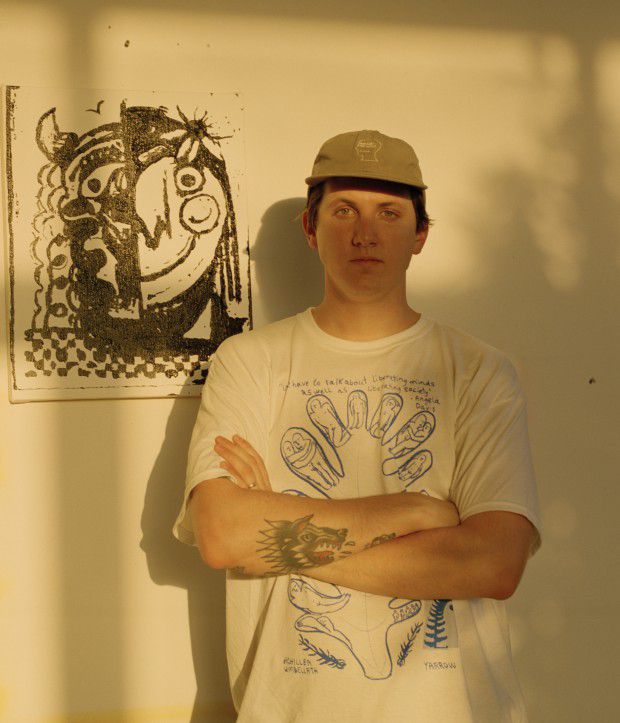
——What kind of pieces are you working on right now?
I’ve been working on a new round of these quilt paintings lately, and painting more oil. Doing a lot of drawings too. I’ve been working on a lot of things at once you know, and kind of what I try to do is a range of paintings and drawings, sculpture and design stuff, and I try to tie them into each other and it really helps to have a lot of things going on at once. I just switch from one thing to another. I’ve been painting these non-stretched canvases, and I am going to stretch them soon. I was trying to have a more relaxing summer. When I paint on stretched canvas it’s a lot of pressure because, I know it sounds silly, but I went through the effort of stretching it, and you know, the stretcher has a cost, my time and labor stretching it has a cost, and by the time I’m ready to paint on the surface, it almost feels too precious. So, I’ve been trying to paint on non-stretch just to kind of like to free myself a little bit and get relaxed in painting, so that’s why I was doing these drawings and stuff too. I’ve been doing these more abstract oil paintings some are almost like Josh Smith’s palette paintings, but a little bit more deliberate than that because I am thinking about what I’m painting on them, but more instinctually than I’m used to working. I enjoy this practice, so I made an effort to do that this summer. I tried not to go into a work thinking, “I’m going to paint a final painting to go into this show or that show.” I have a few shows coming up that I probably should do that for, but I’ve kind of been distracted with this other stuff. It’s like an art vacation.
———Have you always love drawing? I read somewhere that you were really influenced by your family.
Yeah, I think it probably works that way for a lot of people, but yeah, I have a big family. I think they figured out at a young age that that was the easiest way to distract me. Just like my art, I’m always all over the place, and so as a little kid, I was probably a handful. But thinking about it in hindsight, I think they figured out that was the best way for them to distract me from being an obnoxious little kid. But yeah, I definitely have a bunch of creative family members. The whole quilt series is sort of based off of my Grandmother, who was a quilter for most of her life and did a lot of quilt groups and made things with her hands. My Grandmother was first generation, off-the-boat Irish. She made blankets to keep her family warm. It was functional, but they were also pretty creative about the way that they did it. My Grandmother was a sharp lady, and she made some really nice stuff and that’s where these paintings come from. So I’m making all of these smaller paintings and forcing them into these bigger compositions, but I think that’s kind of what a family is. All of these little paintings forced together in larger compositions.
——Is there anything you created as a child that you were really proud of?
I’m trying to think. One time, there was this art competition and I was probably in 3rd grade. My Grandfather was kind of a prankster and he loved playing tricks, and I told him about this project. He was like, “What do you want to do?” and I was like, “I want to paint an invisible castle.” So he told me to not paint anything at all. We found out early on in this contest, that everyone got accepted. So I painted some abstract white sponge prints on silver mylar, called it an invisible castle and submitted that. He thought it was the funniest thing. I think it kind of made him proud, playing this prank on everyone, you know subverting the system. Looking back, it was kind of a smart thing for a third grader to do, but I was kind of just trying to impress him, but it traveled. It went to some other schools, and the Worcester Art Museum, so if I could put maybe one thing on paper that got me really interested in art, it was that. The praise for this super conceptual abstract thing, the admiration of an idea, but I was really just kind of being a smart ass, just having fun.
——Why did you major in illustration and not art in art school?
Well, I originally went for Graphic Design, but I only did because my parents said I couldn’t go to art school, so that was the way I convinced them to let me go. They didn’t think I was going to be able to make money painting, so I had to convince them that Graphic Designers make money. I did that for a semester. I was under the presumption that I had to ask my parents for permission to change my major. After I talked to a couple other classmates, they said that if I am paying for school myself, I could change my major to whatever I wanted. So I changed from Graphic Design to Sculpture, and did that for a semester and then again to Painting. I feel like if I continued there, I’d be a different type of painter now. It wasn’t a bad curriculum, but I didn’t like where I saw it taking me. I have a lot of painter friends who came out of it that are amazing. I just didn’t think it was the right place for me, I talked to this one professor named Kurt Vargo, and he told me about how Illustration is a form of abstract problem solving. I like the idea of being able to solve an abstract problem with an image, and that’s still what a lot of what my work is about. Presenting a non-linear narrative, or an abstract solution to a non-existing problem, like the stating of a fact in a made-up language. I’m glad I went for Illustration just because I don’t think I would have used paint the same way. It taught me how to work fast. The path there wasn’t a super considered one, it just kind of happened.
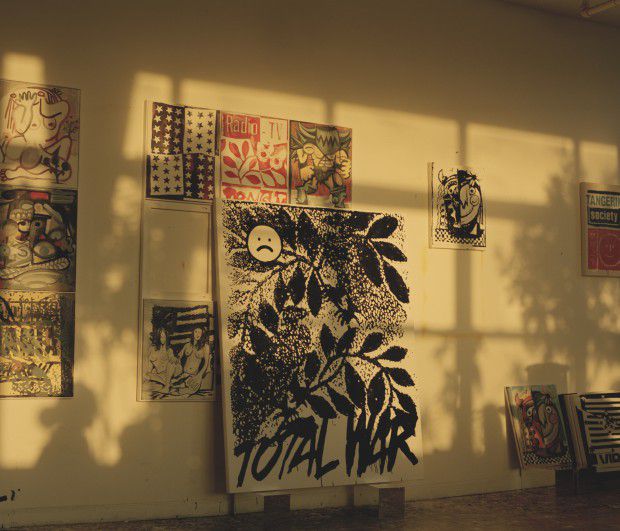
——So you use a lot of words in your art, but do you use them for aesthetic purposes, or do you think about the meanings? Is it a combination of both?
I choose it for both. I choose words because of their forms, because I like the way they look, and the word’s meaning is secondary. Most of the time anyway, it’s not about what they mean, but what they look like compositionally, and I like using words in the work to not mislead the viewer, but to encourage the viewer to interpret an abstract thing or to like project themselves onto and into the painting. Like a projective-reasoning test, like a Rorschach inkblot – where you project meaning onto this abstract thing. That’s what I’m trying do with these, and I understand a word acts as a caption when it’s paired with an image. It’s just interesting to see what people do with it because so often, people come up to me and have interpreted my work in a totally different way. Most of the time, I don’t really go into the work thinking, “This is what this painting means.” Maybe subconsciously, but probably not even that. The way I work, I make these quick collages, and move text and image around based on the composition. I don’t give myself time to put meaning down in the initial sketch, and I purposely cut meaning out as the study progresses.
——So, you display your work not only on walls, but all on different types of surfaces and it’s so unique, but do different surfaces have specific meanings to you and what inspires you to choose them?
I don’t know. I don’t think I really make an image for a surface. It’s more if I find a surface that I think is interesting for me to work on, you know? Those images on the log sculpture, I didn’t make for the log. I did the sketches as studies to be a painting, one day. I do a lot of studies with my Xerox and collages. I think I like the idea of it being kind of applicable. That’s why I like doing t-shirts and all these things because I like the idea of the work like being able to be applied and functional. Beautiful images don’t have to be on a canvas or framed on a wall. I like the idea of it being wrapped around a telephone pole or I don’t know, being painted on a barrel and corrugated metal. Certain things like the corrugated metal have a specific nostalgia for me. I would say that maybe the material has more personal meanings to me than what it is specifically. It’s difficult to say and it depends. It’s project by project too – Like these telephone poles, I did for a show in this gallery, Shrine, and they’re also kind of reminiscent of where I grew up, so it definitely has that meaning, but I don’t think images really correlated with the meaning I had for the material. Like the material has it own attributes where the images are seen as something separate from it, just like two radio stations overlapping when you’re flipping through the channels. I don’t think it’s necessarily like a cause and effect, or point A to point B. It’s not linear, but two things working in tandem.
——Do you tend to work more based on your instincts or do you carefully planning out your art? How do you balance the two?
I work both ways. I will do an instinctive painting, and then photograph it and xerox it and push it into something I can use in one of my more considered works. I could jump around from approach to approach forever. My wife helps me balance that. My wife helps me schedule my time. She is my Studio Manager. I’m very disorganized. I also have a day job, so when I work all day and I walk in the door here to the studio, everything else disappears and I kind of flip a switch. I have this pent up creative energy or something, and it just kind of happens. I know what I want to do or explore. It’s very seldom that I don’t know what I want to work on. Maybe it’s not a painting I want to show, but I definitely I don’t get frustrated with myself anymore. I used to really get frustrated with myself if I spent all this time working on a painting I didn’t like at the end. I’d feel like I wasted my time. I feel like I’m less afraid to just play with an idea for an extended amount of time. If it doesn’t work it doesn’t work. That was part of what this summer was about, and my wife helped a lot. It really helps to have a partner. It really helps to have a sounding board, and also, if I tell her I have 4 shows coming up, she’ll be like, “Hey, I really like what you’re working on, but maybe you should be working on that show right now.” She knows me well. We’ve been going to school since kindergarten together, so she knows how I can be a difficult person and it’s great to have someone help you get organized that you trust. I don’t think a lot of artists are organized thinkers. I’m not. I don’t think very linearly. That’s part of it.
——Your wife helps you a lot, but how about your dogs?
The dogs are great. They give me pause, like literal paws, but also they help me stop for a moment. I don’t know. They’re good. They stay out of the way. We call them art dogs because if I’m painting on the ground, they won’t step on it. If I’m out here playing with them, and a ball rolls towards a painting (a lot of dogs will run into the wall to get the ball) she’ll stop and wait for the ball to roll away. They’re good, they’re really good dogs. Dracula sits here and Tank sits there, and they watch me do my thing. They’re also so sweet when I need a break. It’s good to have that companionship.
——When do ideas come to you?
When I’m sleeping, honestly. First painting came to me when I was asleep. I’ll wake up with an idea, and then write it down in the middle of the night. Hmm when else? On the train, kind of this transition period. I think it very seldom happens when I’m like, “I have to think of a new idea!” I’ve read that cavemen were able to process complex thoughts, and invent the wheel or whatever, when they were comfortable around a fire staring into it. They’d stare into the fire and let their brain relax, and solve these abstract problems. I think that what a comfortable sleep is like. I have a lot of trouble with not feeling productive. I have trouble going to the beach or going on vacation or relaxing what so ever. I need to bring my notebook and sketch and be working. But if I’m taking a train to Boston, or wherever and I’m moving in a certain direction, I feel like I’m being productive and it allows my brain relax. But I think sleeping and these transition times, and stuff like that is usually when I have these eureka moments. They’re not always good, so I’m not saying that’s when I come up with my best ideas, but that’s when I come up with the most ideas.
——What’s your most beautiful memory or moment?
I don’t know. I have really bad memory. It’s crazy because my little brother will tell me about a hilarious situation from when we were kids and I’ll have no recollection of it at all. Or I’ll see a picture of me somewhere, and have no frame of reference for where it is or who took it. I don’t know – My honeymoon was pretty great in Nassau. It was great, but a lot of those places got wiped out in the recent hurricanes. It’s a mess and it’s sad. A lot of people’s best memories happen on these islands, and so many people live on these islands. They’re all damaged severely. Not to bring it to a bummer spot, but it’s pretty real. I don’t know. I really love it here living in the studio. I say a lot that I think this current stage in my life is the best time of my life. The sunset is so nice, and the view is beautiful out the windows. I’m making work that I’ve never been happier about. But I don’t know. I think right now maybe, living in the studio.
——Is it hard to do art in NYC?
I would say it’s harder not to do work in NYC. I think in NYC, I get anxious if I’m not practicing art. Financially, yes, it’s very hard to do artwork in NYC, but I think part of NYC is like figuring out how to work around it. I think it’s harder not to. All of my friends are artists in some way or another, and talking to them when they are excited about their projects, it’s really hard not to take that excitement back to your studio and be excited about your own stuff. I have this guilt about not being productive and socially active, like on the Internet or going out to these openings. The hardest part about NYC is how many opportunities there are to just do it all, and it can be so exhausting, but it’s great.
——Any exciting news or information about ongoing projects?
I don’t know. I have a lot of things I’m excited about. A few things I can’t really disclose yet. I have two shows in October I’m excited about. I’m in the group show in November at Greenpoint Terminal Gallery, which I’m pretty excited about. I’ve been working on a lot of pitches. I have ideas for more conceptual sculptural shows. I do 3D modeling so I’ve been planning sculpture out on the computer. I’ve been working on stuff like that that helps me think and I’m excited about most of that. They may not even happen, but it’s cool to get to try. I have a bunch of stuff coming out. I’m pretty sure I’m showing outside the US in Central America for the first time in February, so that’s going to be cool. The NY Art Book Fair just happened. I’m very goal oriented, and that Book Fair was my goal for the two months prior. I love the Book Fair. It’s my favorite part of NYC. I walk in and everyone I know is there, everyone is happy. Everyone’s doing what they love and showing what they love. That just ended yesterday, so it’s kind of hard for me to think about what the next thing is right now. That’s what this week is going to be about. Oooh, I’m off work next week! I have a vacation, so I’m going to be in the studio all week, so I’m excited about that. That’s what I’m excited about.
——You’re so busy!
It’s good. I love it.
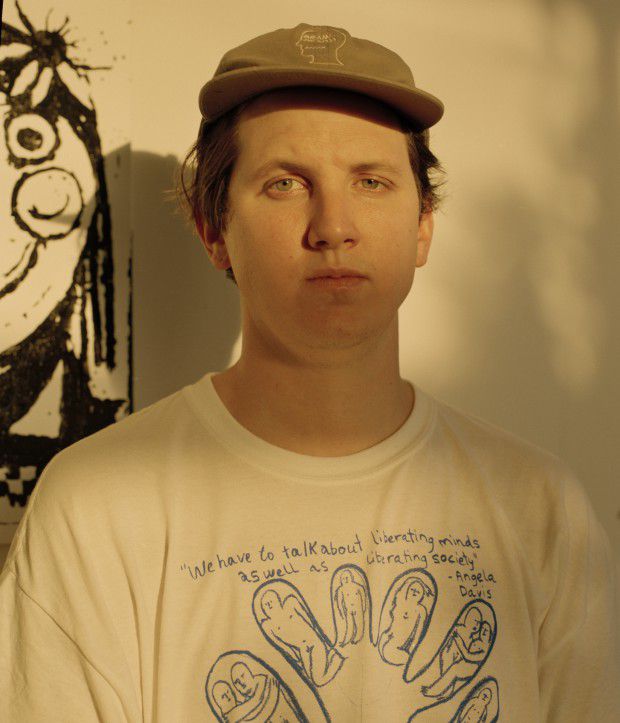
B.Thom Stevenson
https://www.kickstarter.com/projects/1467523769/forward-union-fair
Photography Diego Garcia
Interview Ryoko Kuwahara
coordinator commune(http://www.ccommunee.com)
